
Ahead of Independence Day 2024, the government celebrated the declaration of three more wetlands as Ramsar sites, taking the tally of wetlands of international importance to 85. Union Minister for Environment, Forest and Climate Change (MOEFCC) Bhupender Yadav credited Prime Minister Narendra Modi for the emphasis on establishing harmony with nature, calling our wetlands Amrit Dharohars, and working relentlessly for their conservation.
Modi himself said that it was a joyous occasion and declared that the government will continue to be at the forefront of such efforts in the times to come. This so-called joyous achievement is highly insignificant compared to the ground reality of criminal negligence of wetlands in the country.
Bureaucratic process delays wetlands protection
As per the National Wetland Inventory Assessment done by the Indian Space Research Organisation (ISRO), India has over 7.5 lakh wetlands of which 2.5 lakh are designated as major ones. Sadly though, the bureaucratic process of listing these identified wetlands and then notifying them is a highly time-consuming process. Until they are notified by the States, they do not get any protection.
The listing has to be done by the district-level revenue officials since they maintain the land records and the notification by the State governments. The MOEFCC washed its hands off when I complained about the degradation and destruction of the wetlands of Mumbai and Navi Mumbai. Water is a State subject, the MOEFCC told me and then drew the State’s attention to a Supreme Court ruling that the major wetlands above the size of 2.25 hectares will have to be protected.
Government data
The government has done well in floating the Indian wetlands website to update the water bodies. This remains more of a statistics site than anything else. But so far so good. Now, we know that of the 2.5 lakh major wetlands, just 1,304 are notified. That means only these 1,307 wetlands are notified and hence eligible for protection.
Consider this pathetic situation in the backdrop of the official definition of wetlands. As per the ISRO Atlas, Wetlands are submerged or water-saturated lands, natural or man-made, inland or coastal, permanent or temporary, static or flowing, vegetated or non-vegetated, which necessarily has a land-water interface.
Wetlands role in human history
Wetlands played a major role in human history. It is only wetlands which have always been the sites of sources of water and consequently the development of civilisations. Wetlands are among the most productive ecosystems and play a significant role in the eco-hydrological sustainability of a region. They are an essential part of human civilization meeting many crucial needs for life on earth such as drinking water, protein production, water purification, energy, fodder, biodiversity, water storage, flood mitigation, transport, recreation, research-education, sinks and climate stabilizers.
Yet, there has been criminal negligence of the wetlands all over the country and environmentalists have been screaming in cities such as Mumbai, Delhi, Bengaluru and Hyderabad with little to no response from the thick-skinned and selectively deaf authorities who do not care for even Court rulings.
A Case Study From Mumbai
Since Mumbai is my Karma Bhumi, allow me to discuss a case study from the region. The 1,690-hectare Thane Cree Flamingo Sanctuary (TCFS) is the only Ramsar site in an urban area in the country and it is backed by several satellite wetlands. The State Forest Department and the Bombay Natural History Society (BNHS) have listed at least seven wetlands – Belpada, Bhendkhal, Panje in Uran and DPS, NRI, TS Chanakya in Mumbai and Bhandup in northeast Mumbai – to be protected as second homes of flamingos. The pink birds fly to these satellite wetlands during the high tide.
BNHS has time and again warned that the burial of these wetlands could create chaos in the sky as the birds miss the destinations that they are used to and will fly helter-skelter. This could prove to be disastrous for the flights at the upcoming Navi Mumbai International Airport.
Yet, the wetlands have been under constant attack under the pretext of infrastructure development. The Mangrove Cell had even evinced its interest to protect and conserve the wetlands but the planning authority, the City and Industrial Development Corporation of India (CIDCO) had brushed aside the idea stating that the water bodies are developable land parcels as they were originally either farmlands or salt pans.
(The author is a media veteran, an environmentalist and Director at NatConnect Foundation).